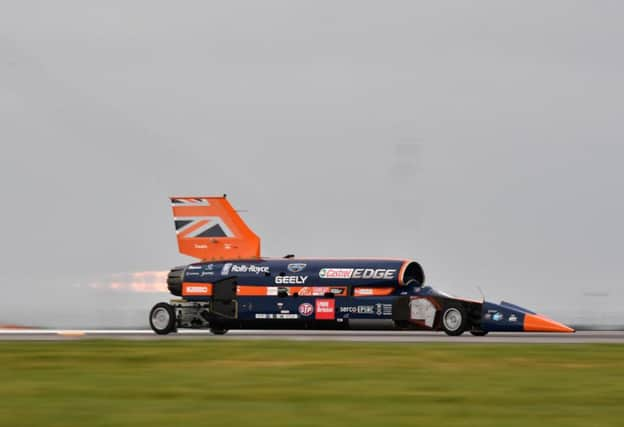Scottish wheels edge Bloodhound jet car towards record


Bloodhound SSC, whose wheels were created in Glasgow, was driven by former RAF fighter pilot Andy Green along the runway at Cornwall Airport Newquay.
The supersonic car accelerated from 0-200mph in eight seconds during the first of two runs.
Advertisement
Hide AdAdvertisement
Hide AdTests in the South African desert next year are expected to take the car to 600mph. Further runs there to 800mph, and then 1,000mph, are scheduled for 2019 or 2020.
The current land speed record, set almost exactly
20 years ago, is 763mph.
More than 3,000 spectators witnessed yesterday’s exercise, which was used to prove the vehicle’s steering, brakes, suspension, data systems and other functions.
The team behind the car described it as a combination of a fighter jet, a Formula One car and a spaceship.
It is fitted with an EJ200 jet engine, sourced from a Eurofighter Typhoon aircraft.
In October 1997, Mr Green was the driver for the Thrust SSC team when they set the current record.
Bloodhound SSC is designed to reach 1,000mph in a bid to set a record that cannot be beaten by existing technology.
Speaking after the Newquay test was completed, Mr Green said: “We came here to show the world Bloodhound is go.
“I cannot think of a better way to do it than that run.
“Two back-to-back runs, the longest runs we’ve done, the highest speeds we’ve done, the most energy going into the brakes.
Advertisement
Hide AdAdvertisement
Hide Ad“The car just said, ‘I can do all of this – I’m designed for supersonic speed but this I can do easily’.”
The car’s wheels were machined by Castle Precision in Glasgow, in collaboration with eight other companies.
Delighted managing director Jan Tiefenbrun, who witnessed the test runs, said it had been a “really excellent day”.
He said the rubber tyres used would be replaced with turbine discs for the desert runs.
These have already been tested to 1,000mph on a free-spinning rig at Rolls-Royce plant in Derby – at 177 revolutions a second, or 10,000 a minute. That would cause any conventional wheel to disintegrate, with the centrifugal forces on the rims 50,000 times the force of gravity.
More than 30 of the Linn Park company’s staff have been involved in the project over the last six years.
Mr Tiefenbrun said: “The Newquay runs have been a great milestone, but they are still just stepping stones and the focus remains on how the car runs in the desert.”